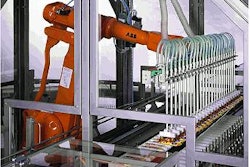In what may be the understatement of the year, Leslye Fraser, director of the Food and Drug Admini-stration’s Office of Regula-tions and Policy, told an audience of food packagers in January that the new Bioterrorism Act’s recordkeeping requirements as they apply to packaging—which go into effect on December 9—“got to be a little complicated, I think, to understand.”
One thing is clear, though. Food manufacturers will have to be able to match up packaging purchased from suppliers with the outgoing shipments of food product packed in it—whether it’s shrink wrap, inner liner, can, bottle, carton, or other packaging.
Beyond that, confusion predominates. The FDA final rule doesn’t say how this “incoming-to-outgoing” link must be established. The rule does say that a food manufacturer must obtain certain information from a packaging supplier, including a lot number for the shipment if a lot number exists.
A food manufacturer must also record the name of the packaging supplier, a description of the packaging including brand name and specific variety, the date it was received, the quantity, and some contact information for the supplier. That information must be recorded at the time it is provided. If there is no lot number, the buyer must find another way to tie that packaging shipment to the outgoing packaged product. Similarly, the manufacturer must record the same type of information for the next company in the distribution chain who receives the food, such as a common carrier.
Records availability
That information must stay on file at the plant for six months to two years, depending on the potential for the product’s spoilage. If the FDA comes knocking, those records have to be produced within 24 hours.
“If the food product manufacturer, processor, or packer puts lot numbers, bar codes, whatever on the outside packaging of the finished product, that is up to them,” says Nega Beru, associate director of the Office of Plant and Dairy Foods at the FDA. Beru was the key FDA decision maker on the final rule issued last December. The FDA has not said whether that identifier on the outgoing product must be placed on the outer package, the bulk carton, or the pallet.
Jeff Barach, senior vice president of special projects at the National Food Processors Assn., Washington, DC, says most food companies are already printing lot numbers on the outer packaging of food products via ink-jet. Those lot numbers on the individual packages are then linked to a batch record that is held in the manufacturing plant for the given product and that details where all the ingredients came from. But those batch records have not included information on packaging for the most part. Starting December 9, they will have to.
Some concessions
The final rule is also noteworthy for what it did not include. It omitted a very controversial proposal—advanced in 2003—that would have required every company in the distribution chain—from the manufacturer all the way to the grocery story—to track the lot number for each individual product. Again, it was never clear whether that tracking referred to the individual outer package, the carton, or the pallet.
Kraft Foods, Inc., Northfield, IL, and nearly every other food company vehemently opposed that proposal because its anticipated cost was high. Christopher Guay, a spokesman for Kraft, had estimated that it would have cost the company $40 million a year to put RFID tags on packages and another onetime cost of $80 million for RFID readers and other equipment.
The FDA’s Beru notes that those cost concerns accounted for a number of changes the FDA made in the final rule, published on December 9, 2004. The most visible change was the ditching of the provision requiring tracking of lot numbers after products left the food plant. But even though the agency made some significant concessions, the final rule still left packagers scratching their heads.
Lots for all packaging?
The confusion was evident at a public meeting the FDA held on January 12. Clay Detlefsen, vice president of regulatory affairs and counsel with the International Dairy Foods Association, Washington, DC, asked Fraser about an instance where a cereal manufacturer is purchasing inner box liners that are in direct contact with the cereal.
The cereal manufacturer may get a lot number from the liner supplier. But the liner is placed inside a cereal box that has a different lot number. “I don’t think food manufacturers will be able to effectively—at this point in time—link and associate lot codes associated with some or all of the food-contact packaging, all the way through the system,” Detlefsen said. “Is it correct that you’re not requiring us to change and do that now?”
“That’s not one I would give a blanket answer to,” Fraser responded. “I think that’s a case-by-case determination. So for me to stand here and say we don’t expect any changes across the board, I will not say that. I do think we expected some changes to be made, which was why we extended the compliance time.”
The FDA’s Beru says the agency will be issuing a guidance document in the future with more definitive information on how manufacturers will have to handle recordkeeping on packaging.
The final rule stems from the Bioterrorism Act passed in the summer of 2002. The purpose of the law is to help the FDA trace to the supplier any food—or packaging, too, it turns out—that could be used as a weapon in a bioterrorist attack. The rule goes into effect for companies with more than 500 employees on December 9, 2005. Companies with 11 to 499 employees get an additional six months; those with fewer than 10 get an additional year.
Not surprisingly, the final rule has proven a touchy topic for food packagers. None wanted to speak, much less be quoted, on the impact of the final rule—whether on packaging or anything else. “Food companies have taken a real low profile on security issues,” says Tim Willard, spokesman for the NFPA.



























